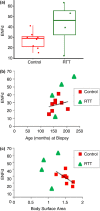A clinical case-control comparison of epidermal innervation density in Rett syndrome
- PMID: 30980517
- PMCID: PMC6520294
- DOI: 10.1002/brb3.1285
A clinical case-control comparison of epidermal innervation density in Rett syndrome
Abstract
Introduction: Rett syndrome (RTT), a rare neurodevelopmental disorder occurring primarily in females (1:10-15,000 female live births), is most often caused by loss-of-function mutations in the X-linked methyl-CpG-binding protein 2 gene (MECP2). Clinical observations and preclinical findings indicate apparent abnormal sensory and nociceptive function. There have been no direct investigations of epidermal sensory innervation in patients with RTT.
Methods: We compared 3 mm epidermal punch biopsy specimens from adolescent female RTT patients (N = 4, aged 12-19 years) against an archived approximate age-, sex-, body-site matched comparison sample of healthy adolescent females (N = 8, ages 11-17).
Results: Confocal imaging revealed, on average, statistically significant increased epidermal nerve fiber (ENF) peptidergic (co-stained calcitonin gene-related protein [CGRP]) innervation density compared with healthy female control individuals.
Conclusions: Given the clinical phenotype of disrupted sensory function along with diagnostic criteria specific to cold hands/feet and insensitivity to pain, our preliminary observations of ENF peptidergic fiber density differences warrants further investigation of the peripheral neurobiology in RTT.
Keywords: MECP2; Rett syndrome; epidermal nerve fiber innervation; sensory phenotype.
© 2019 The Authors. Brain and Behavior published by Wiley Periodicals, Inc.
Conflict of interest statement
None declared.
Figures


References
-
- Bhattacherjee, A. , Mu, Y. , Winter, M. K. , Knapp, J. R. , Eggimann, L. S. , Gunewardena, S. S. , … Smith, P. G. (2017). Neuronal cytoskeletal gene dysregulation and mechanical hypersensitivity in a rat model of Rett syndrome. Proceedings of the National Academy of Sciences, 114, E6952–E6961. 10.1073/pnas.1618210114 - DOI - PMC - PubMed
MeSH terms
Substances
Grants and funding
LinkOut - more resources
Full Text Sources
Medical
Research Materials

